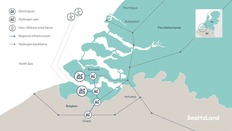- The SeaH2Land project aims to develop a 1 GW electrolyser by 2030.
- A 2 GW offshore wind farm will supply the necessary renewable electricity.
- A 45 km hydrogen pipeline will connect industrial players in the Dutch-Flemish North Sea Port cluster.
- The project targets the production of renewable hydrogen for steel, ammonia, ethylene, and fuels.

Project Overview
SeaH2Land is an ambitious project aiming to link a 1 GW electrolyser to the large industrial demand in the Dutch-Flemish North Sea Port cluster via a regional cross-border pipeline. The renewable hydrogen will be produced using green electricity from a new 2 GW offshore wind farm in the Dutch North Sea.
Industrial Collaboration
Major industrial companies in the region, including ArcelorMittal, Yara, Dow Benelux, and Zeeland Refinery, support the development of the necessary infrastructure. This collaboration aims to produce sustainable steel, ammonia, ethylene, and fuels, contributing to carbon reduction goals for the Netherlands and Belgium by 2030 and beyond.
Infrastructure Development
The project includes a regional open-access pipeline network of about 45 km, connecting large-scale hydrogen consumption and production sites. The network will stretch from Vlissingen-Oost (NL) to Gent (BE) and can be extended further to connect additional industrial sites.
Phased Implementation
The first phase of SeaH2Land will unlock 500 MW of electrolyser capacity, with a second phase scaling up to 1 GW. This will require a connection to a national hydrogen backbone for additional flexibility and storage. Several locations north and south of the river Scheldt have been identified for GW-scale electrolysis.
Regulatory Framework
The partnership will engage with regulatory authorities to establish the necessary framework and policies to support the development of renewable hydrogen linked to large-scale offshore wind. This initiative aligns with the Hydrogen Delta Programme for the region, supported by the Provinces of Zeeland and Oost-Vlaanderen.

